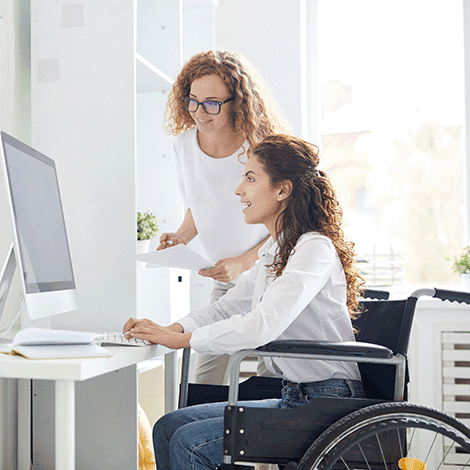Everyone should work in a place where they feel safe and comfortable – with easy access to whatever they need in order to do their job well, and with dignity. With greater focus on accessibility across society – from visual aids that make websites easier to read to the installation of automatic doors, wider corridors and ramps – inclusivity is a priority for any forward-thinking service and workplace.
The Equality Act 2010 recommends employers make ‘reasonable adjustments’ according to cost and practicality for their physical space – e.g., while there may be access limitations within an old/listed building and limited resources to fix them, alternative solutions should be sought.
Changes must also be made, according to the act, when standard working processes or practices make it difficult for an employee to access what they need. This could be in terms of an adjustment to where a staff meeting is usually held, or making parking available closer to the building for those who need it.
In terms of a workplace’s physical features, which may present mobility barriers, alternative options should be created where possible – such as step-free access, accessible handles/buttons, and clear signage.
Improving workplace technology is another consideration that can positively impact both on-site and remote workers when used to create a sense of community as well as work communications.
While larger organisations are likely to have more resources than others to improve the experiences of wheelchair users, attitude counts for a lot – a willingness to listen and anticipate the differing needs of employees. That said, no one should feel their fundamental needs are drawing unnecessary attention – such as having to accept help to open a door or navigate a narrow thoroughfare. And while most non-disabled people wouldn’t think twice about offering to help, there should never be a need for it in an accessible environment. Independence and dignity go hand in hand.
Accessibility ideas for wheelchair users
Physical accessibility
Ensure ramps, elevators, wide doorways, and accessible restrooms are available. Hallways and pathways should be clear of obstacles.
Workstation design
Provide adjustable desks and workstations to accommodate different wheelchair heights. Ensure workspace layout allows for easy manoeuvrability.
Parking
Designate accessible parking spaces close to the entrance and provide a clear path from the parking area to the building entrance.
Technology accessibility
Use adaptive technologies like screen readers, enlarged fonts, and alternative input devices to make digital tools and software accessible.
Communication aids
Use clear and simple language in written materials. Provide sign language interpreters or captioning for meetings and training sessions.
Training and sensitivity
Train staff to be sensitive to the needs of wheelchair users and disabled colleagues, fostering a respectful and inclusive environment.
Emergency evacuation plans
Develop evacuation plans that include procedures for wheelchair users to safely exit the building in case of emergencies.
Furniture and fixtures
Choose accessible furniture and fixtures, including wheelchair-friendly seating, tables, and toilet facilities.
Visual and auditory accessibility
Provide visual and auditory cues for announcements and alerts, as some wheelchair users might have sensory impairments.
Ask for feedback
Regularly seek feedback from wheelchair users to identify areas for improvement and make necessary adjustments.
Employers who fail to make accessibility improvements are liable to discrimination claims by employees if they believe more could be done to help them in the workplace, so don’t be afraid to set up one-to-ones, forums or lunch and learns to keep in tune with the changing needs of your workforce. Evaluate feedback, see whether changes are warranted and within your means, explain your decisions and find mutually agreeable solutions.
Looking to hire a diverse workforce, or work for a forward-thinking employer? Contact one of our specialist consultants to start your journey.



